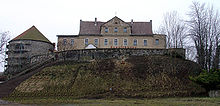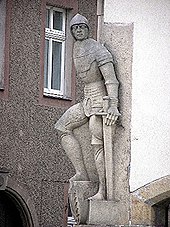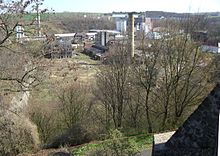Dohna
| coat of arms | Germany map | |
|---|---|---|
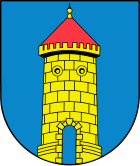
|
Coordinates: 50 ° 57 ' N , 13 ° 51' E |
|
| Basic data | ||
| State : | Saxony | |
| County : | Saxon Switzerland-Eastern Ore Mountains | |
| Management Community : | Dohna-Müglitztal | |
| Height : | 160 m above sea level NHN | |
| Area : | 28.59 km 2 | |
| Residents: | 6183 (Dec. 31, 2019) | |
| Population density : | 216 inhabitants per km 2 | |
| Postal code : | 01809 | |
| Primaries : | 03529, 0351, 03501, 035027 | |
| License plate : | PIR, DW, FTL, SEB | |
| Community key : | 14 6 28 080 | |
| LOCODE : | DE DHA | |
| City structure: | 12 districts | |
City administration address : |
Market 11 01809 Dohna |
|
| Website : | ||
| Mayor : | Ralf Müller ( CDU ) | |
| Location of the town of Dohna in the Saxon Switzerland-Eastern Ore Mountains district | ||
Dohna is the second oldest city in the Free State of Saxony . It is located in the district of Saxon Switzerland-Eastern Ore Mountains and is the seat of the administrative association Dohna-Müglitztal .
geography
location
The city of Dohna is located about 15 km southeast of Dresden and south of Heidenau at the entrance to the Müglitztal as the gateway to the Eastern Ore Mountains . It is located on the eastern edge of the northern roof of the eastern Ore Mountains , the so-called Elbe valley slate area between Gottleuba and Dohna. The castle was built on a narrow granite spur of the Müglitz built is circled. The city itself is located on the Taschenberg, a river terrace with a subsoil made of planar sandstone .
Districts
Dohna is divided into the core city and the two localities Meusegast and Röhrsdorf . The core city consists essentially of the old town and the lower town . In addition to Meusegast itself, the village of Meusegast also includes Köttewitz and Krebs . The significantly larger village of Röhrsdorf includes, in addition to Röhrsdorf itself, the districts of Borthen , Bosewitz , Burgstädtel , Gamig , Gorknitz , Sürßen and Tronitz .
Many of the village squares still recognizable today in the style of the Slavic round villages have been preserved over the centuries. Examples of this are the Rundplatzdörfer (Rundlinge) Sürßen, Borthen, Burgstädtel, Gorknitz and Bosewitz.
history
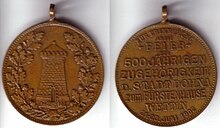
Dohna is the second oldest city in Saxony . The name is considered to be the Old Sorbian place Donin , which belonged to the Don or Dohna . Archaeologically, settlements can be traced back to the Bronze Age around 1800–1600 BC. Chr. ( Robisch and Burgberg ramparts ). The Burgberg dominates the entrance to the Müglitz Valley and is secured by a loop of the Müglitz .
Therefore, the castle and settlement at this point were of particular importance for the control of the trade routes ( salt roads ) in the Müglitztal (Bohemian way) and over the heights ( Kulmer Steig or Alte Dresden Teplitzer Poststrasse ). The Annalista Saxo mentioned Dohna between 1148 and 1152 in the year 1040: the army of King Henry III. gathered at Dohna and undertook a seven-day incursion into Bohemia via the Kulmer Steig . In 1076 Henry IV enfeoffed Duke Vratislav II of Bohemia with the districts Budissin and Nisan , to which Dohna also belonged. He gave Nisan and Dohna as a dowry for his daughter in the marriage with Wiprecht von Groitzsch , but under the suzerainty of Vratislav II.
Around the middle of the 12th century, probably as early as 1143 or 1144 under King Konrad III. , the Burgraviate of Dohna came as an imperial fiefdom to the noble Heinricus de Rodewa , who is in their possession no later than 1156 and who became the founder of the noble noble family of the Donins (first mentioned in 1127 in the Pleißenland between Altenburg , Chemnitz and Zwickau on both sides of the Pleiße ).
As burgraves directly from the empire, the Donins had a great influence on the settlement of the Eastern Ore Mountains . With the large-scale clearing and planting of a large number of villages, they gained great wealth and thereby also gained power and influence; they even strove to rule the country. Evidence for this is the issuing of own documents, founding cities, own ministerial , own coin rack (see Donin's bracteates ) and jurisprudence. The Dohnaer Schöppenstuhl achieved great importance as a noble feudal court . Your burgraviate lay between the margraviate of Meißen and the Kingdom of Bohemia and stretched from Gottleuba in the east to Rabenau in the west and from the Elbe in the north to the Ore Mountains in the south (including Lauenstein , Bärenstein and Frauenstein ). They had the fortification sovereignty because they were royal governors. They were entitled to the 3rd pfennig and 1/3 of the duty of the Dresden Elbe bridge . The burgrave Conrad von Dohna received the order to build the planned city of Dresden in 1170 from Emperor Barbarossa , which also included the construction of the first stone bridge in Dresden in the 13th century. Around 1221 or possibly until 1226, the Burgrave of Dohna built a fort-like curie , his court of law, on the bridgehead .
In 1228 he fortified the court to a moated castle , because he had a dispute over his rights in Dresden with the Meissen margrave. The nobility dance in Dresden in 1400, the burgrave used the sought-after opportunity to break out an open feud with the Meissen margrave Wilhelm the One-Eyed . This, however, from then on besieged the Dohna Castle, which urged Burgrave Jeschke to flee from it. He fled to Weesenstein , then to Königstein and then to Hungary, where he was beheaded as a peace-breaker after his capture in Ofen (Budapest) . Until the defeat of the Donins in the Dohna feud in 1402, Dohna Castle was the center of direct imperial rule. In 1402 the castle was completely destroyed by miners from Dippoldiswalde and Freiberg . The burgraviate was taken over by the Meissen margrave.
Like the entire region, the affiliation of the place Dohna changed between Bohemia and the Mark Meissen.
After the military defeat of the Donins in 1402, the Wettins enfeoffed their vassals for loyalty and military service with the goods of the Burgraviate of Dohna, for example in 1410 Günther and Heinrich von Bünau with Liebstadt and Kuckuckstein Castle and the associated villages.
The Dohna Castle remained the administrative seat until 1460 (this was moved to Pirna in the Sonnenstein Castle in 1457 ) and then fell into disrepair. A settlement was established on the neighboring Taschenberg under the protection of the castle. This is first referred to as "Stettichin" (town) in 1445 and appears as a town in the documents from 1590. However, Dohna did not receive the full city constitution until 1845.
The name of the town varied from Donin (1107, 1160, 1206), Donyn (1288, 1408), Doneyn (1454) to Dhonin, Donow and finally Dohna. Hey explains his origins with "possession of the Doň" (from the Bohemian personal name Zdoň).
The economy was mainly shaped by farmers and artisans, especially butchers , trimmers and straw hat makers .
The butcher guild of Dohna had received the right in 1462 to deliver their goods to Dresden. The free estate on the market and the butcher's fountain, consecrated in 1912, still bear witness to this important privilege.
Since the entire region was often affected by wars, Dohna naturally also suffered from hardship, misery and illness during the Thirty Years , Seven Years and the Napoleonic Wars . In the latter, the city was heavily devastated during the fighting between Russian and French troops on the “Imperial Night” of 1813. A number of cannonballs and house inscriptions remind of this .
In 1927 a strong flood raged in the village and the Müglitz caused severe damage.
With the municipal reform in the Free State of Saxony, the municipality of Köttewitz-Krebs was incorporated on March 1, 1994. On January 1, 1999, Meusegast and Röhrsdorf came to the city of Dohna. Since January 1, 2002, the city of Dohna has formed an administrative community with the neighboring municipality of Müglitztal .
Incorporations
| Former parish | date | annotation |
|---|---|---|
| Borthen | January 1, 1993 | Incorporation to Röhrsdorf |
| Bosewitz | July 1, 1950 | Incorporation to Gorknitz |
| Burgstädtel | July 1, 1950 | Incorporation to Borthen |
| Gorknitz | January 1, 1993 | Incorporation to Röhrsdorf |
| Köttewitz | January 1, 1970 | Merger with Krebs to form Köttewitz-Krebs |
| Köttewitz cancer | March 1, 1994 | |
| cancer | January 1, 1970 | Merger with Köttewitz to form Köttewitz-Krebs |
| Meusegast | January 1, 1999 | |
| Röhrsdorf | January 1, 1999 | |
| Sweetness | July 1, 1950 | Incorporation to Gorknitz |
| Tronitz | July 1, 1950 | Incorporation to Gorknitz |
politics
City council
Since the local elections on May 26, 2019, the city council has been composed as follows:
| CDU | Free voters | The left | Green | AfD |
|---|---|---|---|---|
| 5 seats | 7 seats | 2 seats | 1 seat | 1 seat |
coat of arms
Description: In blue, a crenellated black grooved golden round tower with an open archway, two small round windows and a red pointed roof with a gold knob.
Symbolism: The coat of arms is based on a seal image from 1525. The tower refers to a larger castle.
Culture and sights
- see also: List of cultural monuments in Dohna
- Castle tower (attempted reconstruction at the beginning of the 19th century), Burgschänke was set up as a rifle house in 1828, bowling alley from 1832 and hall from 1910.
- The late Gothic three-aisled Marienkirche Dohnas dates from 1489, the carved altar from 1518, the sandstone baptismal font from the 15th century, a flight of stairs to the tower from 1684 and classical tombstones in the churchyard.
- Electoral Saxon post distance column from 1731 on the market and Electoral Saxon quarter milestone No. 7 of the Alte Dresden-Teplitzer Poststrasse from 1732 on Reppchenstrasse / Weesensteiner Strasse
- "Old Pharmacy" from 1690 to 1992 (today local museum)
- Ratskeller with a sculpture of a knight (probably Burgrave Jeschke ) and Renaissance portal from the 16th century, guest room with groin vault and Tuscan central column
Cultural activities
Dohna has a local history museum with the permanent exhibition on castles and grave fields on the " Kulmer Steig " (Dohna from the Stone Age to the Iron Age ), on the castle, burgraves and burgraviate Dohna, with a mineral and fossil cabinet and on the agricultural town of Dohna and the Dohna handicrafts ( especially butcher, straw weaving, straw hat production). There are also special exhibitions every year, for example at Easter and Christmas.
Since 1975, the blossom festival has been held in the fruit-growing region of Borthen-Röhrsdorf every year at the beginning of May when the apples are in bloom.
As of 2008, the "Wilischlauf", well-known beyond the city limits of Dresden, has found its domicile at the Saxon-Bohemian farmers' market in Röhrsdorf. The "Wilischlauf" takes place every year in mid-April. Since 2010 the “Dohnaer Sportpokal” has included four runs (Wilischlauf, Flower Festival Run, Müglitztallauf, Advent Run) and two duathlons (Saxony Championship and Osterzgebirgs-Challenge), which are organized in the Dohna area, for a local cup classification.
school
Dohna has a primary and a high school . The school was inaugurated on September 7, 1891 and expanded from 1897 (inauguration of the annex with auditorium on September 7, 1908). The gym dates from 1892, to which a new extension with modern technology was built and inaugurated in 2003. On October 4th 1969 the school was named " Marie Curie ".
Memorials
- Cenotaph from 1952 on Dresdner Strasse for the victims of fascism , including Rudolf Gebauer, Anna Hirsch, Carl Strehle, Richard Lorenz, Otto Kretzschmar, Arthur Unganz, Marie Gebauer, Alwin Rössel, Heinrich Flegel and Rudolf Richter from Dohna
- Commemorative plaque on the residential building at Pestalozzistraße 7 for Rudolf Gebauer , who was murdered in 1938 in Dresden police headquarters
- Memorial plaque on the house at the former Ernst-Thälmann-Straße 128 for Anna Hirsch , who lost her life in Auschwitz in 1942
- Grove of honor in the cemetery on Burgstrasse for 28 named resistance fighters and victims of fascism
Economy and Transport
economy
Today, the economic situation in Dohna is shaped by small and medium-sized enterprises, local handicrafts and service providers, as well as agriculture and fruit and horticulture.
In 2010, a total of 2,208 employees subject to social security contributions were recorded in the city, 896 of which were in the mining and manufacturing sector.
The most important resident companies include four companies of the DGH Group (Druckguss Heidenau GmbH, Heidenauer Formen- und Werkzeugbau, Diecasting Technology Center and Zerspanungs- und Industrietechnik GmbH) with around 350 employees. The DGH-Group supplies a wide range of aluminum and magnesium die casting as well as gray and nodular cast iron, in particular to automobile manufacturers.
The fluorine chemistry Dohna GmbH produced within the fluorine chemistry group hydrofluoric acid and anhydrite . Dohna is one of the oldest hydrofluoric acid production sites in Europe. Production here goes back to 1903. In the attached Dohna Anhydrit Mischwerk GmbH plant, anhydrite is processed into high-quality building materials.
SPS Schiekel Präzisionssysteme GmbH produces components made of rustproof / stainless steel with around 110 employees.
F&S Prozessautomation GmbH has been based in Dohna with around 80 employees since 1995. In addition to automation, control technology, protection and drive technology for energy, industry and infrastructure, the company also offers its own low and medium voltage converters . In addition to the headquarters of the group of companies, the production center, E&A Elektrotechnik und Automatisierung GmbH, is also located in Dohna.
In addition to these larger industrial production companies, several craft, service and trading companies are located in Dohna.
Fruit growing is of particular importance on the heights to the left of the Müglitztal in the area around Borthen, Röhrsdorf, Gamig, Gorknitz, Bosewitz, Sürßen and Tronitz. The producers have come together in the producer group "Borthener Obst eG". The community farmed an area of 1,500 hectares in 2010 and achieved a total yield of almost 30,000 tons, including 27,300 tons of apples, 1,150 tons of sour cherries, 595 tons of strawberries, 370 tons of plums and small amounts of pears, raspberries, currants, blackberries and gooseberries. The fruit grown here is marketed in a cooperative market that is also used by Bohemian traders, the Saxon-Bohemian farmers' market in Röhrsdorf.
traffic
Dohna can be reached via the S 178 from Heidenau . The road continues to Altenberg . The city can be reached from Pirna via the B 172a .
The A 17 runs directly past Dohna (about one kilometer as the crow flies to the city's historic market). The connection point Pirna is located directly at the city entrance between the districts of Köttewitz and Krebs. The motorway junctions 5 Heidenau and 6 Pirna are in the Dohna area.
The regional traffic is realized on the one hand by bus connections to Heidenau, Pirna and Altenberg as well as by the city line Dresden to Borthen and Röhrsdorf, on the other hand by the Müglitztalbahn from Heidenau to Altenberg.
Personalities
sons and daughters of the town
- Romy Beer (* 1981), biathlete
- Dieter Bellmann (1940-2017), actor
- Norbert Bläsner (* 1980), politician (FDP), MdL
- Matthias Döschner (* 1958), footballer
- Lars Drawert (* 1976), cameraman and film producer
- Siegmar Faust (* 1944), writer and screenwriter , 1996–1999 State Commissioner of the Free State of Saxony for the Stasi files
- Jens Fiedler (* 1970), track cyclist
- Hubertus Giebe (* 1953), painter and graphic artist
- Thomas Goller (* 1977), athlete
- Martin Karl Hasse (1883–1960), university professor, composer and music writer
- Christian Kaden (1946–2015), musicologist
- René Herms (1982–2009), track and field athlete and Olympic participant
- Lars Jungnickel (* 1981), footballer
- Christian Wilhelm August Königsdörffer (1781–1851), important bridge builder on the Dresden – Leipzig railway line
- Friedrich Georg Mering (1822–1887), doctor, pathologist and professor of medicine in Kiev, from 1871 spokesman for the Kiev Duma
- Jan Mixsa (* 1970), actor, voice actor, set designer and puppeteer
- Marco Morgenstern (* 1972), biathlete
- Friedrich Wilhelm von Oppel (1720–1769), Saxon chief miner and co-founder of the Freiberg Mining Academy
- Wolfgang Pauly (1876–1934), chess problem composer
- Falk Putzke (* 1980), racing cyclist
- Holm Putzke (* 1973), university professor
- Frank Rühle (* 1944), rower, 1968 and 1972 Olympic champion in the four-man boat class without a helmsman
- Anne Schumann (* 1966), violinist and lecturer in baroque music
- Tom Wlaschiha (* 1973), actor
- Katja Wüstenfeld (* 1976), biathlete
People connected to the city
- Julius Wilhelm von Oppel (1766–1832), founder of the Sophienanstalt in Krebs
Individual evidence
- ↑ Population of the Free State of Saxony by municipalities on December 31, 2019 ( help on this ).
- ^ Ernst Eichler and Hans Walther : Saxony. All city names and their history , Faber and Faber Verlag, Leipzig 2007, ISBN 978-3-86730-038-4 , p. 53.
- ↑ MGH SS 6, 684 .
- ↑ Bardo (1031-1051) - RIplus Regg. EB Mainz 1 [after 1027] - 1040 Aug. 15 to 31, Dohna: Collection of an army at the Dohna castle and a seven-day invasion of Bohemia. Saxones quoque cum metropolitano Mogontie Bardone et Ekkihardo marchione in predicta sancte Virginis festivitate Donin convenerunt, et eandem regionem, divina eos, ut patuit, protectione comitante, cum parva admodum manu die dominica 9 kal. Septembris violenter introierunt, et per 9 dies potestative peragrantes, cede, preda, incendio vastaverunt, donec tandem, venerabili viro Guntario monacho cum legatione regis adveniente et acta docente reditumque suadende, pace data et accepta, victores exierunt. Annalista Saxo. in: MGH SS 6, 684; .. Saxones autem cum metropolitano Mogontiaco Bardone et Ekkehardo marchione [Misnensi] convenerunt et eandem regionem [Bohemiam], divina eos ut claruit protectione comitante, cum parva admodum manu, the dominica 9 cal. Septembris violenter introierunt, et per novem dies potestative peragrantes, cede, praeda incendioque vastaverunt, donec venerabili viro Guntario monacho cum legatione regis adveniente, pace data et accepta, victores redierunt. Ann. Magdeb. in: MGH SS 16, 172. RIplus Regg. EB Mainz 1 [after 1027], in: Regesta Imperii Online, URI: http://www.regesta-imperii.de/id/b3340f79-50bb-4698-8faa-97be22684e40 (accessed on July 23, 2020).
- ↑ Heinricus de Rodewa in a document by Konrad for the Chemnitz monastery from February 1143; Heinrich is named as a witness. See the edition of the certificate at: The documents of Konrad III. and his son Heinrich, arr. v. Friedrich Hausmann (= MGH DD, Vol. 9), Vienna / Cologne / Graz 1969, No. 86, pp. 152–154, here p. 154, line 17 . For the first mention cf. Karlheinz Blaschke, Dohna. In: Lexikon des Mittelalters, Vol. 3, Munich a. a. 1983, col. 1166; Dohna - a short historical overview on the website of the city of Dohna
- ↑ Heinricus castellanus de Donin in a document from Margrave Conrad I of Meißen from November 30, 1156; Heinrich is named as a witness. Cf. Codex diplomaticus Saxoniae regiae , IA 2: The documents of the Margraves of Meissen and Landgraves of Thuringia 1100–1195, ed. by Otto Posse , Leipzig 1889, no. 262, pp. 176-179, here p. 178, line 37 . Cf. Lothar Graf zu Dohna: Dohna. In: New German Biography (NDB). Volume 4, Duncker & Humblot, Berlin 1959, ISBN 3-428-00185-0 , pp. 43-46 ( digitized version )., P. 43.
- ↑ Gustay Hey: The Slavic Settlements in the Kingdom of Saxony. Wilhelm Baensch KS Hofverlagsbuchhandlung, Dresden 1893, p. 68.
- ^ Alfred Meiche: Book of legends of Saxon Switzerland and its peripheral areas. 2nd Edition. the revised 2nd edition from 1929. Altis-Verlag GmbH, Berlin 1997, ISBN 3-910195-02-4 , p. 153
- ↑ Municipalities 1994 and their changes since January 1, 1948 in the new federal states , Metzler-Poeschel publishing house, Stuttgart, 1995, ISBN 3-8246-0321-7 , publisher: Federal Statistical Office
- ↑ StBA: Changes in the municipalities in Germany, see 1999
- ↑ Municipal council election 2019: Eligible voters, voters, ballot papers, distribution of votes and seats in the election on May 25, 2014 in the district city of Dohna; District of Saxon Switzerland-Eastern Ore Mountains. statistik.sachsen.de ( State Statistical Office of the Free State of Saxony ), May 2014, accessed on December 14, 2014 .
- ↑ State Statistical Office of Saxony - Dohna municipal statistics 2011
- ^ Homepage of the DGH Group
- ↑ Fluorchemie Dohna GmbH. Fluorochemistry Group, accessed April 8, 2018 .
- ↑ Homepage SPS Schiekel Präzisionssysteme GmbH
- ↑ Future, permanently solved. F&S Prozessautomation GmbH, accessed on December 19, 2018 .
- ↑ 20th anniversary of the producer group "Borthener Obst eG" ( Memento from August 1st, 2012 in the web archive archive.today )
literature
- Christian Bartsch: History of the old castle and Städgens Dohna. Dresden / Leipzig 1735 ( digitized version )
- Alfred Meiche: Historical-topographical description of the Pirna administration. Dresden 1927. ( digitized version )
- Alfred Meiche: Book of legends of Saxon Switzerland and its peripheral areas. 2nd Edition. the revised 2nd edition from 1929. Altis-Verlag, Berlin 1997, ISBN 3-910195-02-4 .
- Georg Friedrich Möring (Ed.): Dohna. City and castle from its origins to the present day . Dohna 1843 ( digitized version )
- Max Winkler, Hermann Raußendorf: The burgrave town of Dohna. In: Communications from the Saxon Homeland Security Association . Volume XXV, Issue 1–4 / 1936, Dresden 1936, pp. 1–38.
- Richard Steche : Dohna. In: Descriptive representation of the older architectural and art monuments of the Kingdom of Saxony. 1. Booklet: Official Authority Pirna . CC Meinhold, Dresden 1882, p. 11.
- Eckhart Leisering: Acta sunt hec Dresdene - the first mention of Dresden in the document dated March 31, 1206 , Sächsisches Staatsarchiv, Mitteldeutscher Verlag (mdv), Halle / Saale and Dresden 2005, pages 96, ISBN 978-3-89812-320-4 . Explanations of the place Dohna and Henricum burcgravium de Donin p. 5/11/20 / 25–34 / 33 / 49–50
Web links
- Official website of the city of Dohna
- Dohna in the Digital Historical Directory of Saxony



